Positioning a ladder company apparatus is usually not an issue when you’re first due, but what happens when you’re not? Will the chauffeur be able to get the rig into a location that allows its aerial ladder or tower ladder bucket to be useful for firefighting tactics? When you encounter obstacles such as curbs, wires, trees, and streetlights in your response district, it can be difficult to position around them. Drill on these obstacles and make sure all firefighters assigned to these units know the tactics to use prior to encountering such obstacles at an incident. When you arrive on the scene of a fire or an emergency, that isn’t the time to come up with how you’re going to overcome an obstacle. Constant training/refresher training on apparatus setup is an effective way to pass on the information and make members proficient in getting the rig into a workable position (photo 1).
RELATED FIREFIGHTER TRAINING
Firefighting Basics: Positioning Fire Apparatus, Part 1 | Part 2
Training Minutes Revisited: Repositioning Aerial Apparatus
The Do’s and Don’ts of Positioning Aerial Apparatus on the Fireground

(1) Drilling has to be realistic; flying a tower ladder only in a parking lot doesn’t make a good operator. Flying around obstacles such as streetlights and down alleyways makes firefighters more experienced with their apparatus and fire district. (Photos 1-5 and 8 by Kevin Ciampo.)
Cribbing and Jack Pads vs. the Curb
If you think carrying just the jack pads that came with your apparatus from the dealership is going to help you on every outrigger deployment, you better rethink your strategies. The fireground is full of obstacles, and one of these little nuisances is the curb. Whether it’s a concrete, asphalt, or cobblestone curb, you can expect it to be a problem for the outrigger to sit on.
Many may just say “short-jack” the outrigger—it’s only a foot or so—but what happens when you’re operating to the short-jacked side and your apparatus computer shuts down your operation and you can’t override it? You surely don’t want to come up short if you’re in the process of removing a victim from the window.
Another problem is when a tower ladder takes a corner position in the intersection to cover two sides of the structure, it deploys its outriggers, and one is going to be put down on top of a utility cover (which is cast iron and can break when you put thousands of pounds of pressure on top of it). How would you overcome this obstacle?
Truck company apparatus should carry a variety of cribbing sizes. And don’t think just square items are the answer. Whether you prefer wood or newer plastic cribbing, carry various sizes such as 2 × 4, 4 × 4, 4 × 6, and wedge cribs. Place them alongside the curb and then you can place the jack pad on top so the outrigger sits properly. If there isn’t concrete or asphalt on the opposite side of the curb, there will probably be grass; throwing a few 2 × 4s down under the jack plate may help level out the outrigger, prevent it from sinking, and offer more support when you put it down (photos 2, 3).
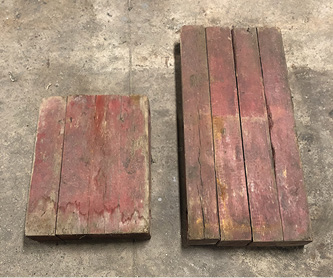
(2) These 4 x 4 cribbing sets are homegrown innovations that many truck companies carry on their apparatus.
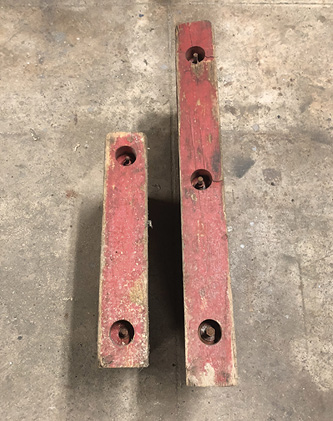
(3) These pieces of cribbing are through bolted with threaded rod and pieced together to form a substantial base for outriggers and jacks.
Carrying wedge chocks or step chocks can also assist in outrigger positioning when you encounter beveled curbs and the sidewalk entrance ramps usually found at street corners or intersections. Depending on the grade of the curb or roadway, using these chocks to level out the ramp will allow the outrigger to sit in a level position, thus enhancing the overall stability of the apparatus.
Another important cribbing item to carry is planking. Carrying two to four 3- to 4-foot pieces of planking on the apparatus will help you span a utility cover. Some truck companies prefer to carry 4- × 6-inch or 3- × 12-inch pieces of planking while others prefer to carry 4- × 4-inch sectional cribbing. These pieces are usually four individual lengths bolted together with a piece of threaded rod. They are all long enough to span the obstacle the outrigger is being placed on. Attaching pieces of webbing or seat belts to these longer pieces makes them easier to carry and put into position (photo 4).

(4) Attaching pieces of seat belts, tubular webbing, or strapping adds handholds for lifting and positioning pieces of cribbing.
During cold winter months, the impact of the outrigger and the weight of the apparatus resting on these cast iron covers could cause them to snap, crack, and fail. Bridging the cover with the planking will help reduce the chances of that occurring. Sometimes, you may encounter open grating utility covers; spanning them with the planks can aid in outrigger deployment. When doing so, ensure that the planking is long enough to span the entire framing and sits on a substantial footing at each end; otherwise, the grating could fail and the outrigger could collapse through it and possibly topple the apparatus.
Arriving Second Due
Arriving as the second-due truck makes choosing an apparatus position a bit more difficult for the officer and chauffeur. Other apparatus may already be in place and operating. Also, you may encounter overhead obstructions such as trees or wires. Prior to leaving the cab of the apparatus, the officer should communicate to the chauffeur to go up to the fire building and see if “circling the block” and approaching the fire building from the opposite direction is achievable. Many times, by doing this, the apparatus will be able to cover the other side of the structure with the ladder or bucket. It also gives firefighters another means of access and egress and another area to set up master stream operations (photo 5).
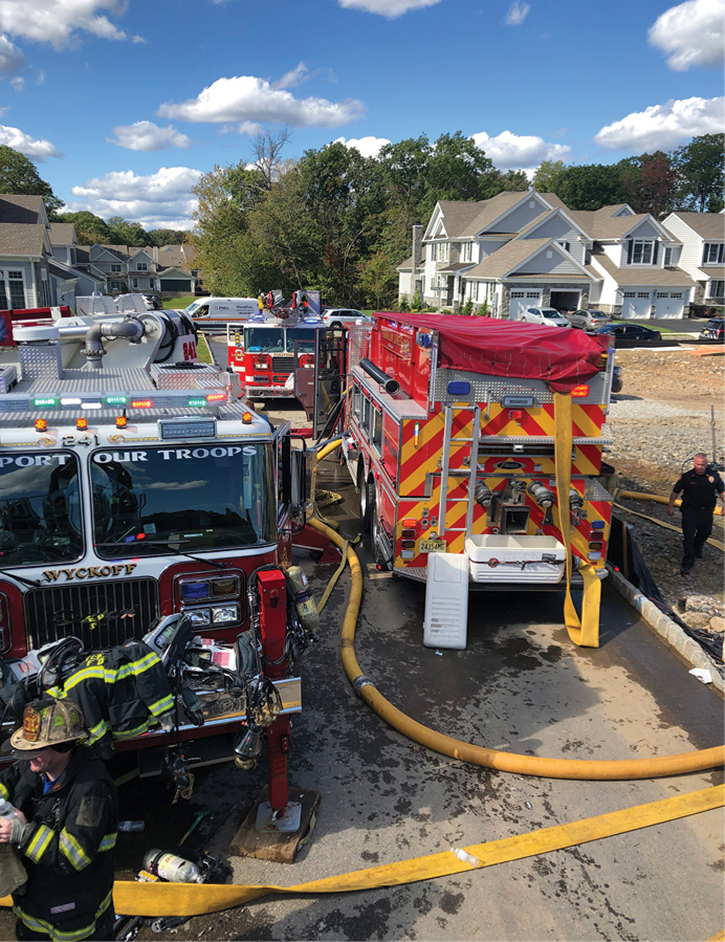
(5) Arriving at this multiple alarm later in the response sequence can limit positioning options.
Another positioning option very valuable for rear-mount tower ladders and aerial ladders is to back into the block. By doing this, they can use the entire length of their aerial device to cover the fire building or an exposure. If they were to just pull in, they would lose the bed length of the ladder because it is operating over the apparatus. Often with this tactic, the ladder can work underneath or side-by-side with the first operating truck’s ladder. Backing in from the opposite direction can also be of value when circling the block.
Always use caution when backing up fire apparatus; have at least one spotter work with the chauffeur. The spotter should be in the chauffeur’s mirror so the chauffeur can see any hand signals being used. At night, the spotter should shine a flashlight on the ground as the rig proceeds backward. Don’t shine the light up into the mirror; it can disorient the chauffeur’s view. Many newer rigs have backup cameras, but the spotter is also there to warn pedestrians and firefighters moving behind the apparatus.
Many cities around the country have rear alleys that can run the entire block behind the structures. Many departments have the second-due truck enter the alley to position for laddering the rear of the fire building. Often, there are a host of obstacles in these alleys—parked or abandoned cars, trash receptacles, piles of rubbish, telephone poles, fences, and overhead obstructions (wires and trees). Navigating through the obstacles can be difficult and may delay a truck in getting into position. If you are delayed getting into position, inform by radio the units operating on the fireground so they know a second means of egress from the rear isn’t in place.
When approaching the structure, the officer and chauffeur should communicate to each other what obstructions they see. They may have to decide whether to position the apparatus past the building or stop before the building to raise the ladder under any wires or trees to access the building. It also may be possible to angle the rig away from the building so you can swivel the boom under the overhead obstructions and extend toward the structure. On rear-mount ladders and midship tower ladders, you also can pass the building and back under the overhead obstructions to get the ladder in position. Remember, if you’re operating a tower ladder in the rear, trying to catch two sides of the building from the rear is just as important as when you position in front of the structure.
Since alleyways are often narrow and have a host of obstructions, it can be very difficult to place outriggers. Always strive to have the “work side” outriggers fully deployed and properly cribbed. The apparatus will be working off the side of the rig, and the last thing you need is for the computer to prevent the boom from extending or rotating. Plus, you don’t want the rig to topple over if you short-jacked the work side and overloaded the ladder or bucket. Accidents have occurred and usually point back to improperly positioned outriggers or the ground failing beneath the outrigger. Short-jacking the nonwork side of the rig often is done in these narrow areas, but strive to get the outrigger into the best possible position for overall apparatus stability.
Overhead Obstructions
Ladder companies often face numerous types of overhead obstructions while positioning and must quickly process a series of questions: Can the apparatus operate under these obstructions? Can we cut the tree branches or limbs to get into position? Will we be able to back or nose under the obstruction to reach the building, or can we leave the roadway to get a position? If you can answer some of these, then immediately begin positioning the apparatus. If you can’t address any, revert to placing portable ladders onto the structure for firefighter access and egress. Too many times, truck companies rely on only the ladder or bucket for placement on the fire building. Portable ladders are more maneuverable and easier to position on all sides of a structure (photos 6, 7).
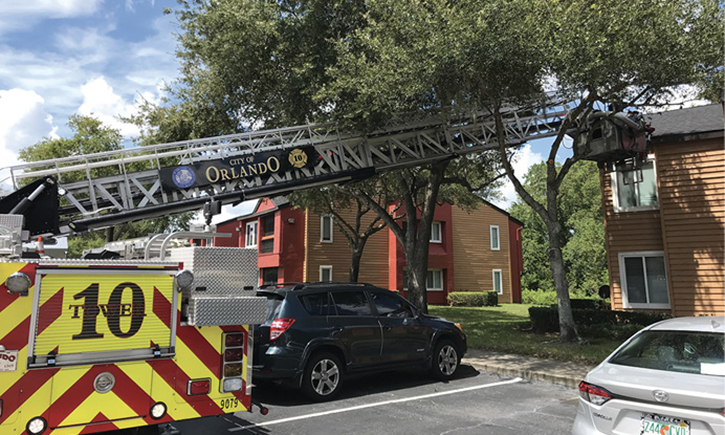
(6) Overhead tree limbs and branches can be removed if the apparatus can’t boom through them to reach the fire building. (Photos 6 and 7 by JJ Cassetta.)
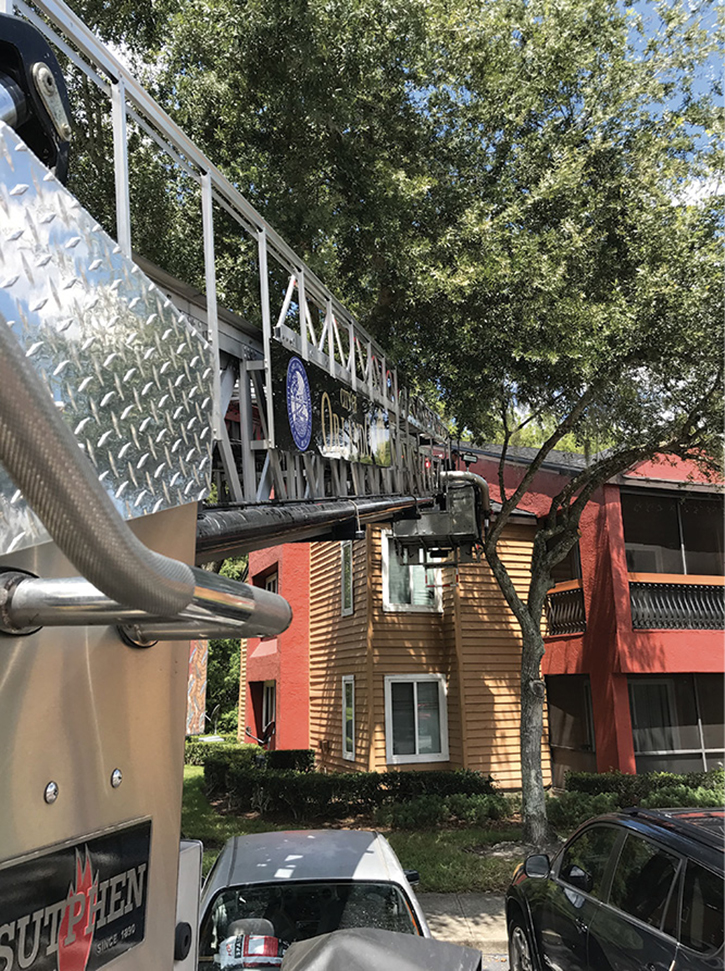
(7) When retracting the boom, ensure no limbs will impede operations. Wedging a large branch or limb in the boom can cause damage to the apparatus or cease operations without warning.
When you cut overhead tree branches, always try to position the ladder or bucket above the branch. This way, once you cut the branch, it won’t fall on the ladder or members operating in the bucket of the tower ladder. In addition, you will lessen the chances of the branch falling on any part of the apparatus and causing damage to a hydraulic or an electrical power line. If you are cutting the limb from the bucket, the saw operator must immediately hit the chain brake on the chain saw on completion of the cut. When two firefighters are operating in the bucket, you don’t want to injure the other firefighter with the chain spinning on the bar of the saw.
It’s also important to stage a firefighter on the ground to watch the “drop zone” of the materials from above. Members operating below won’t expect a large limb to fall and injure them.
Prior to beginning cutting operations, always ensure no electrical power lines are entwined in the branches or close to your operating area. They could snap when the branch topples down on them and possibly hit the apparatus. Don’t put the members operating on the ladder, bucket, or pedestal in danger with a live electrical line falling on the apparatus.
Nosing in or backing in under wires running parallel with the roadway is another way to overcome these overhead obstacles. Nosing into a driveway cutout may enable a mid-mount tower ladder to duck under the wires in front of the structure to get coverage of the front of the building and down the side driveway.
If the rig is in the middle of the street, it may be possible to work under the wires, depending on their height, but you may only be covering one side of the building. Plus, you won’t have the reach down the driveway because the apparatus is out in the middle of the roadway. The value of a tower ladder is that it can cover two sides of a structure for vent-enter-search (VES) operations as well as master stream operations. Nosing into position is a very good tactic at wood-frame dwellings with narrow driveways in between them.
With rear-mount aerials and tower ladders as well as midship rigs, you can also back in under the wires to reach the structure. If the building sits farther off the road, the rear-mount apparatus can use its full reach to ladder the building. Once the ladder or boom comes out of the cradle, you can rotate it around to operate under the wires. When a midship apparatus does this, it will lose the bed section of the ladder or boom that remains over the body of the truck. However, it will now be able to operate under the wires and ladder the fire building.
If the apparatus has to leave the roadway when backing into the structure, the chauffeur and officer should examine the ground before doing so. If the ground is of uncertain stability, place the planks carried on the apparatus onto the ground to prevent the rig from sinking. Use the other cribbing to ensure the outriggers have a substantial base when placed on the ground. If possible, the boom or ladder should operate inline with the apparatus so the weight is evenly distributed if possible. If not, the pedestal operator must always keep an eye on the outriggers and the footing beneath them.
Irregular Building Shape
Knowing your alarm district and the types of structures prevalent in it can help you gain a mental picture prior to arrival at an incident. Responding into other areas for mutual aid or on a greater alarm can prove to be more difficult for a building size-up. However, with today’s advances in technology, you can pull up the building on a tablet or apparatus computer and get a street and satellite view. Doing so can enhance apparatus positioning prior to your arrival. Often, you’ll run into oddball situations or structures with different construction features that can be out of the norm for regular apparatus positioning. Add overhead obstacles or roadway and driveway irregularities, and apparatus positioning can be difficult.
A size-up of the building’s shape can help you choose a position. Often, tower ladders will position with their turntables in the “throats” of the buildings (the area between both wings). They do this to provide coverage of a greater area, which allows more areas to VES and more windows to direct master stream operations to prevent the fire from spreading from one wing to the other.
Other building irregularities may include a gambrel-style roof on a structure, which may need to be vented, overhauled, or checked for extension (photo 8). Positioning inline with the structure to gain access and through overhead obstructions may be necessary. At these structures, it’s imperative the chauffeur take a few seconds to get a good size-up of the building, the fire’s location, and potential fire spread. Saving time in the beginning of an operation can make a big difference in overall apparatus positioning.

(8) The tower ladder was backed into position so the crew could work out of the bucket and perform operations on this gambrel-shaped roof.
These are just some of the obstacles and conditions firefighters will face when arriving on the scene of a structural fire with a ladder apparatus. How you can operate around or wipe out a problem should be on every chauffeur’s mind. Being aggressive with getting your apparatus into a workable position is fine, but make sure it’s a safe and effective location for firefighters who are going to operate off the ladder or in the bucket.
MICHAEL N. CIAMPO is a 35-year veteran of the fire service and a lieutenant in the Fire Department of New York. Previously, he served with the District of Columbia Fire Department. He has a bachelor’s degree in fire science from John Jay College of Criminal Justice in New York City. He is the lead instructor for the FDIC International Truck Essentials H.O.T. program. He wrote the Ladders and Ventilation chapters for Fire Engineering’s Handbook for Firefighter I and II (Fire Engineering, 2009) and the Bread and Butter Portable Ladders DVD and is featured in “Training Minutes” truck company videos.

